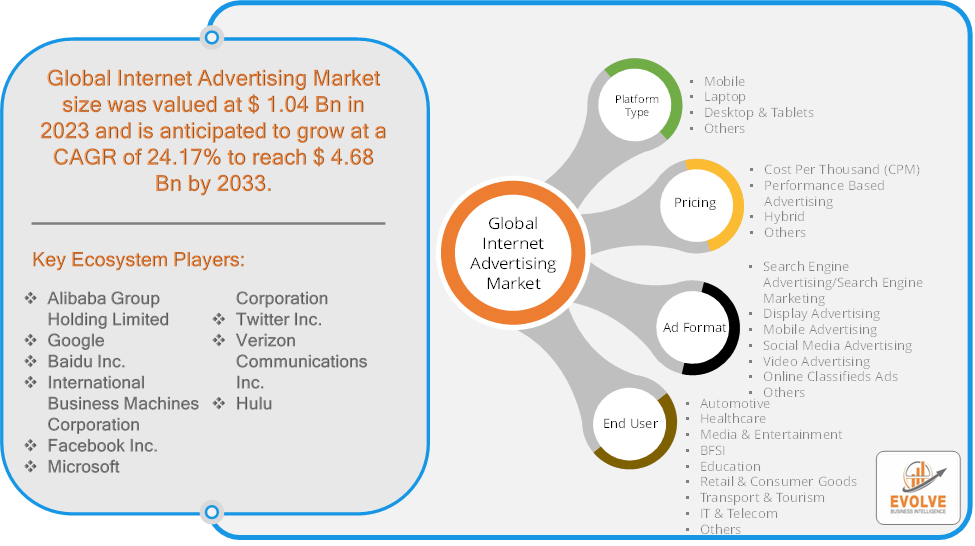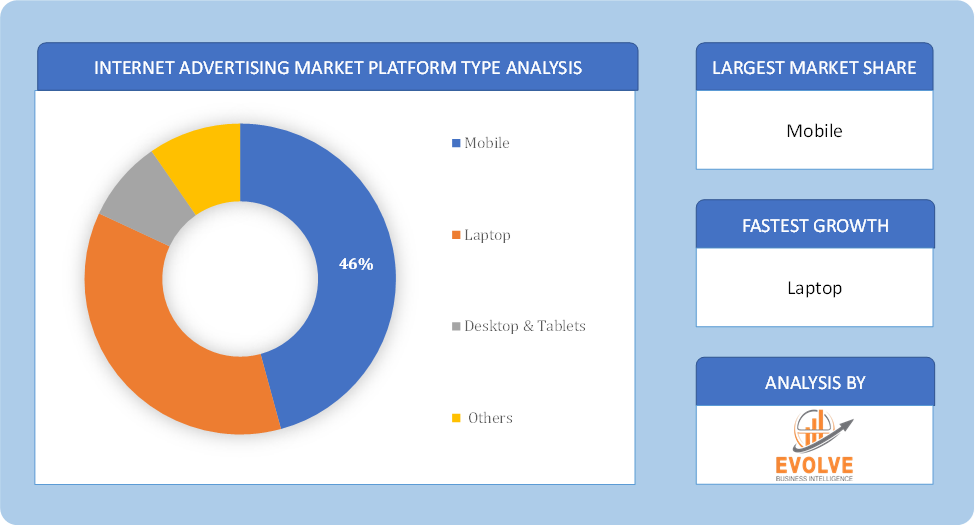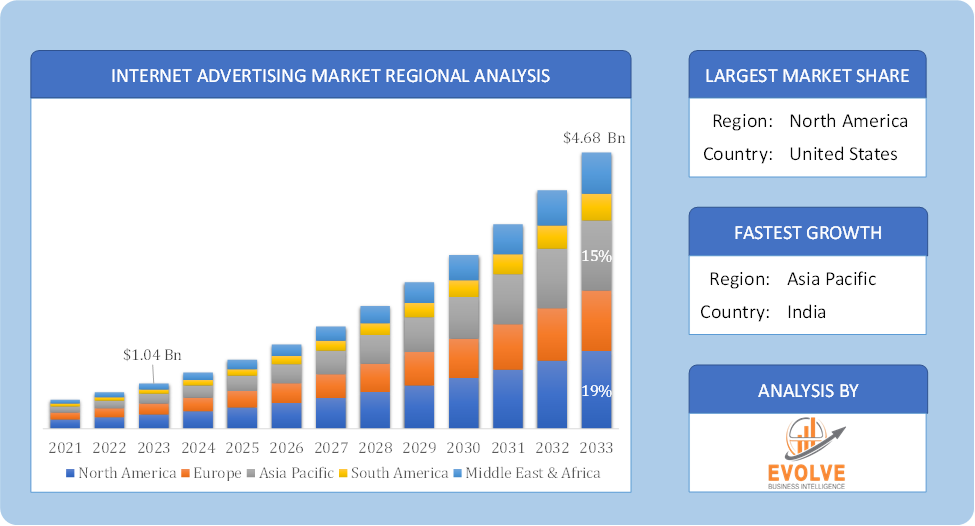Internet Advertising Market Analysis and Global Forecast 2023-2033
$ 1,390.00 – $ 5,520.00Price range: $ 1,390.00 through $ 5,520.00
Internet Advertising Market Research Report: Information By Platform Type (Mobile, Laptop, Desktop, & Tablets, Others), By Pricing (Cost Per Thousand (CPM), Performance Based Advertising, Hybrid, Others), By Ad Format (Search Engine Advertising/Search Engine Marketing, Display Advertising, Mobile Advertising, Social Media Advertising, Video Advertising, Online Classifieds Ads, Others), By End-User (Automotive, Healthcare, Media & Entertainment, BFSI, Education, Retail & Consumer Goods, Transport & Tourism, IT & Telecom, Others), and by Region — Forecast till 2033
Page: 171
Internet Advertising Market Overview
The Internet Advertising Market Size is expected to reach USD 4.68 Billion by 2033. The Internet Advertising Market industry size accounted for USD 1.04 Billion in 2023 and is expected to expand at a compound annual growth rate (CAGR) of 24.17% from 2023 to 2033. The Internet Advertising Market refers to the sector of the advertising industry focused on promoting products, services, or brands through online platforms. The internet advertising market refers to the ecosystem where businesses utilize online platforms and digital technologies to promote their products or services to a target audience.
The Internet Advertising Market has grown rapidly due to the increasing penetration of the internet and mobile devices, along with advancements in data analytics, which allow for highly targeted and personalized advertising strategies. It is driven by businesses aiming to reach specific audiences more effectively and measure the impact of their campaigns in real-time.
Global Internet Advertising Market Synopsis
The COVID-19 pandemic had a significant impact on the Internet Advertising Market. In the initial stages of the pandemic, many businesses reduced their advertising budgets due to economic uncertainty. Sectors like travel, hospitality, and retail, which were heavily impacted by lockdowns and restrictions, scaled back their advertising efforts significantly. The pandemic accelerated the digital transformation of many businesses, leading to a more permanent shift towards online advertising. Companies that previously relied on traditional marketing channels increased their digital presence, contributing to sustained growth in the Internet Advertising Market. The economic pressures of the pandemic heightened the need for measurable and cost-effective advertising strategies. This led to an increased reliance on data analytics, performance marketing, and programmatic advertising, where ad spend could be optimized in real-time. The pandemic altered consumer behavior, with more time spent online, leading to a shift in how and where people engage with content. Advertisers adapted by focusing on channels where consumers were most active, such as streaming platforms, social media, and mobile apps. The rise in digital ad spend also led to increased risks of ad fraud and concerns over brand safety, where ads could appear next to inappropriate or harmful content. Advertisers had to invest more in technologies and strategies to mitigate these risks.
Internet Advertising Market Dynamics
The major factors that have impacted the growth of Internet Advertising Market are as follows:
Drivers:
Ø Increasing Internet and Mobile Penetration
The widespread adoption of the internet and smartphones has significantly expanded the audience for digital advertising. As more people gain access to the internet, particularly in emerging markets, the potential reach of online ads continues to grow. With a substantial portion of internet users accessing content primarily through mobile devices, advertisers are increasingly focusing on mobile-friendly ad formats and platforms. The rapid growth of e-commerce, particularly accelerated by the COVID-19 pandemic, has increased the demand for digital ads that drive traffic to online stores. Retailers are heavily investing in search engine marketing (SEM) and social media ads to capture online shoppers. The integration of e-commerce with social media platforms, enabling users to shop directly from ads, has further fueled the demand for internet advertising.
Restraint:
- Perception of Ad Blockers and Consumer Resistance
The widespread use of ad blockers by consumers, particularly on desktops, reduces the reach of internet ads. As more users install ad blockers to avoid intrusive ads, advertisers face challenges in delivering their messages to their intended audiences. Many users are increasingly resistant to online ads, especially those that are overly intrusive or irrelevant. This ad fatigue can lead to lower engagement rates and necessitates the development of more creative and less intrusive advertising strategies.
Opportunity:
⮚ Advancements in AI and Machine Learning
AI and machine learning enable advertisers to analyze vast amounts of data to create highly personalized ad experiences. These technologies can predict consumer behavior, optimize ad placement in real-time, and improve the relevance of ads, leading to higher engagement and ROI. The continued growth of programmatic advertising, powered by AI, offers opportunities for more efficient and effective ad buying. Advertisers can automate ad placements, optimize bids, and target specific audiences with greater precision. The expanding user base on social media platforms like Facebook, Instagram, Twitter, LinkedIn, and newer platforms like TikTok provides a significant opportunity for targeted social media advertising. Brands can leverage these platforms to reach specific demographics and engage with their audience in real-time.
Internet Advertising Market Segment Overview
Based on Platform Type, the market is segmented based on Mobile, Laptop, Desktop, & Tablets and Others. The Mobile segment dominant the market. This has become an integral part of the digital marketing landscape. Mobile devices are ubiquitous, allowing advertisers to reach large audiences anytime, anywhere. They can complement broader digital advertising strategies, creating a consistent brand experience across different platforms. As a result, the shift to mobile Internet advertising has become a significant trend in recent years, reflecting the growing dependence on mobile devices for Internet access and content consumption, this will promote the use of mobile phones and smartphones will drive growth of the target market during the forecast period.
By Pricing
Based on Pricing, the market has been divided into Cost Per Thousand (CPM), Performance Based Advertising, Hybrid and Others. The Cost Per Thousand (CPM) segment dominant the market.
By Ad Format
Based on Ad Format, the market has been divided into Search Engine Marketing, Display Advertising, Mobile Advertising, Social Media Advertising, Video Advertising, Online Classifieds Ads and Others. The Search Engine Marketing segment dominant the market. Due to a surge in the number of consumers who purchase and research things online, Furthermore, the demand for global firms to be more accessible, searchable, and visible on the internet is driving the search engine advertising industry to flourish.
By End User
Based on End Users, the market has been divided into Automotive, Healthcare, Media & Entertainment, BFSI, Education, Retail & Consumer Goods, Transport & Tourism, IT & Telecom and Others. The Global Retail & Consumer Goods (vertical) segment dominant the market. The most significant regional market for Retail & Consumer Goods is China.
Global Internet Advertising Market Regional Analysis
Based on region, the global Internet Advertising Market has been divided into North America, Europe, Asia-Pacific, the Middle East & Africa, and Latin America. North America is projected to dominate the use of the Internet Advertising Market followed by the Asia-Pacific and Europe regions.
 Internet Advertising North America Market
Internet Advertising North America Market
North America holds a dominant position in the Internet Advertising Market. North America, particularly the United States, is one of the largest and most mature markets for internet advertising. High internet penetration, advanced digital infrastructure, and a strong e-commerce ecosystem contribute to the region’s leadership in digital advertising and the region is a hub for technological innovation, with widespread adoption of advanced advertising technologies such as programmatic advertising, AI-driven targeting, and data analytics. The U.S. is also a leader in social media and video advertising, with platforms like Facebook, Instagram, and YouTube driving significant ad revenue.
Internet Advertising Asia-Pacific Market
The Asia-Pacific region has indeed emerged as the fastest-growing market for the Internet Advertising Market industry. Asia-Pacific is one of the fastest-growing regions in the Internet Advertising Market, driven by the increasing penetration of the internet and mobile devices, particularly in countries like China, India, Japan, and Southeast Asia. Many countries in this region are mobile-first, with a significant portion of the population accessing the internet primarily through smartphones. This has led to the dominance of mobile advertising, including in-app ads and mobile video ads.
Competitive Landscape
The global Internet Advertising Market is highly competitive, with numerous players offering a wide range of software solutions. The competitive landscape is characterized by the presence of established companies, as well as emerging startups and niche players. To increase their market position and attract a wide consumer base, the businesses are employing various strategies, such as product launches, and strategic alliances.
Prominent Players:
- Alibaba Group Holding Limited
- Baidu Inc.
- International Business Machines Corporation
- Facebook Inc.
- Microsoft Corporation
- Twitter Inc.
- Verizon Communications Inc.
- Hulu
Key Development
In February 2021, D.A.Consortium Inc. announced that Spotify AB has recognized it as a Spotify Advertising Partner. Through its DSP MarketOne, DAC will work directly with Spotify to deliver reservations-based marketing.
Scope of the Report
Global Internet Advertising Market, by Platform Type
- Mobile
- Laptop
- Desktop & Tablets
- Others
Global Internet Advertising Market, by Pricing
- Cost Per Thousand (CPM)
- Performance Based Advertising
- Hybrid
- Others
Global Internet Advertising Market, by Ad Format
- Search Engine Advertising/Search Engine Marketing
- Display Advertising
- Mobile Advertising
- Social Media Advertising
- Video Advertising
- Online Classifieds Ads
- Others
Global Internet Advertising Market, by End User
- Automotive
- Healthcare
- Media & Entertainment
- BFSI
- Education
- Retail & Consumer Goods
- Transport & Tourism
- IT & Telecom
- Others
Global Internet Advertising Market, by Region
- North America
- US
- Canada
- Mexico
- Europe
- UK
- Germany
- France
- Italy
- Spain
- Benelux
- Nordic
- Rest of Europe
- Asia Pacific
- China
- Japan
- South Korea
- Indonesia
- Austalia
- Malaysia
- India
- Rest of Asia Pacific
- South America
- Brazil
- Argentina
- Rest of South America
- Middle East & Africa
- Saudi Arabia
- UAE
- Egypt
- South Africa
- Rest of Middle East & Africa
| Parameters | Indicators |
|---|---|
| Market Size | 2033: USD 4.68 Billion |
| CAGR (2023-2033) | 24.17% |
| Base year | 2022 |
| Forecast Period | 2023-2033 |
| Historical Data | 2021 (2017 to 2020 On Demand) |
| Report Coverage | Revenue Forecast, Competitive Landscape, Growth Factors, and Trends |
| Key Segmentations | Platform Type, Pricing, Ad Format, End User |
| Geographies Covered | North America, Europe, Asia-Pacific, South America, Middle East, Africa |
| Key Vendors | Alibaba Group Holding Limited, Google, Baidu Inc., International Business Machines Corporation, Facebook Inc., Microsoft Corporation, Twitter Inc., Verizon Communications Inc. and Hulu |
| Key Market Opportunities | · Advancements in AI and Machine Learning |
| Key Market Drivers | · Increasing Internet and Mobile Penetration
· E-commerce Expansion |
REPORT CONTENT BRIEF:
- High-level analysis of the current and future Internet Advertising Market trends and opportunities
- Detailed analysis of current market drivers, restraining factors, and opportunities in the future
- Internet Advertising Market historical market size for the year 2021, and forecast from 2023 to 2033
- Internet Advertising Market share analysis at each product level
- Competitor analysis with detailed insight into its product segment, Government & Defense strength, and strategies adopted.
- Identifies key strategies adopted including product launches and developments, mergers and acquisitions, joint ventures, collaborations, and partnerships as well as funding taken and investment done, among others.
- To identify and understand the various factors involved in the global Internet Advertising Market affected by the pandemic
- To provide a detailed insight into the major companies operating in the market. The profiling will include the Government & Defense health of the company’s past 2-3 years with segmental and regional revenue breakup, product offering, recent developments, SWOT analysis, and key strategies.
Frequently Asked Questions (FAQ)
What is the study period of this market?
The study period of the global Internet Advertising Market is 2021- 2033
What is the growth rate of the global Internet Advertising Market?
The global Internet Advertising Market is growing at a CAGR of 4.68% over the next 10 years
Which region has the highest growth rate in the market of Frozen Food?
Asia Pacific is expected to register the highest CAGR during 2023-2033
Which region has the largest share of the global Internet Advertising Market?
North America holds the largest share in 2022
Who are the key players in the global Internet Advertising Market?
Alibaba Group Holding Limited, Google, Baidu Inc., International Business Machines Corporation, Facebook Inc., Microsoft Corporation, Twitter Inc., Verizon Communications Inc. and Hulu are the major companies operating in the market.
Do you offer Post Sale Support?
Yes, we offer 16 hours of analyst support to solve the queries
Do you sell particular sections of a report?
Yes, we provide regional as well as country-level reports. Other than this we also provide a sectional report. Please get in contact with our sales representatives.
Press Release

Global Pharmaceutical Manufacturing Market to Reach $1.38 Trillion by 2035 with 7.35% CAGR, New Research Shows

The Global Mammography Market Is Estimated To Record a CAGR of Around 10.29% During The Forecast Period

Glue Stick Market to Reach USD 2.35 Billion by 2034

Podiatry Service Market to Reach USD 11.88 Billion by 2034

Microfluidics Technology Market to Reach USD 32.58 Billion by 2034

Ferric Chloride Market to Reach USD 10.65 Billion by 2034

Family Practice EMR Software Market to Reach USD 21.52 Billion by 2034

Electric Hairbrush Market to Reach USD 15.95 Billion by 2034

Daily Bamboo Products Market to Reach USD 143.52 Billion by 2034

Cross-border E-commerce Logistics Market to Reach USD 112.65 Billion by 2034
Table of Content
CHAPTER 1. Executive Summary CHAPTER 2. Scope of the Study 2.1. Market Definition 2.2. Market Scope & Segmentation 2.2.1. Objective of Report CHAPTER 3. Evolve BI Methodology 3.1. Data Collection & Validation Approach 3.2. Market Size Estimation and Forecast CHAPTER 4. Exclusive Analysis 4.1. Market Opportunity Score 4.1.1. Component Segement – Market Opportunity Score 4.1.2. Deployment Mode Segment – Market Opportunity Score 4.1.3. Enterprise Size Segment – Market Opportunity Score 4.1.4. End User Segment – Market Opportunity Score 4.2. Key Market Influencing Indicators CHAPTER 5. Market Insights and Trends 5.1. Value Chain Analysis 5.1.1. Raw Material 5.1.2. Manufacturing Process 5.1.3. Distribution Channel 5.1.4. End User 5.2. Porter’s Five Forces Analysis 5.2.1. Bargaining Power of Buyers 5.2.2. Bargaining Power of Suppliers 5.2.3. Threat of New Entrant 5.2.4. Threat of Substitute 5.2.5. Industry Rivalry 5.3. COVID-19 Impact and Post COVID Scenario on Internet Advertising Market 5.3.1. Impact of COVID-19 5.3.2. Government Support and Industry Revival Policies 5.3.3. Measures Taken by Companies to Mitigate Negative Impact 5.3.4. Post COVID Trend CHAPTER 6. MArket Dynamics 6.1. Introduction 6.2. Drivers 6.2.1. Driver 1 6.2.2. Driver 2 6.2.3. Driver 3 6.3. Restraints 6.3.1. Restraint 1 6.3.2. Restraint 2 6.4. Opportunity 6.4.1. Opportunity 1 CHAPTER 7. Internet Advertising Market, By Component 7.1. Introduction 7.1.1. Software 7.1.2. Services CHAPTER 8. Internet Advertising Market, By Deployment Mode 8.1. Introduction 8.1.1. On-Premise 8.1.2. Cloud-based CHAPTER 9. Internet Advertising Market, By Enterprise Size 9.1. Introduction 9.1.1. Large Enterprises 9.1.2. Small- & Medium-sized Enterprises CHAPTER 10. Internet Advertising Market, By End User 10.1.Introduction 10.1.1. Energy and Utilities 10.1.2. Oil and Gas 10.1.3. Manufacturing 10.1.4. Mining and Metals 10.1.5. Healthcare and Life Sciences 10.1.6. Chemical and Pharmaceuticals 10.1.7. Government and Defense 10.1.8. IT and Telecom 10.1.9. Food and Beverages 10.1.10. Others CHAPTER 11. Internet Advertising Market, By Region 11.1. Introduction 11.2. NORTH AMERICA 11.2.1. North America: Market Size and Forecast, By Country, 2023 – 2033 ($ Million) 11.2.2. North America: Market Size and Forecast, By Component, 2023 – 2033 ($ Million) 11.2.3. North America: Market Size and Forecast, By Deployment Mode, 2023 – 2033 ($ Million) 11.2.4. North America: Market Size and Forecast, By Enterprise Size, 2023 – 2033 ($ Million) 11.2.5. North America: Market Size and Forecast, By End User, 2023 – 2033 ($ Million) 11.2.6. US 11.2.6.1. US: Market Size and Forecast, By Component, 2023 – 2033 ($ Million) 11.2.6.2. US: Market Size and Forecast, By Deployment Mode, 2023 – 2033 ($ Million) 11.2.6.3. US: Market Size and Forecast, By Enterprise Size, 2023 – 2033 ($ Million) 11.2.6.4. US: Market Size and Forecast, By End User, 2023 – 2033 ($ Million) 11.2.7. CANADA 11.2.7.1. Canada: Market Size and Forecast, By Component, 2023 – 2033 ($ Million) 11.2.7.2. Canada: Market Size and Forecast, By Deployment Mode, 2023 – 2033 ($ Million) 11.2.7.3. Canada: Market Size and Forecast, By Enterprise Size, 2023 – 2033 ($ Million) 11.2.7.4. Canada: Market Size and Forecast, By End User, 2023 – 2033 ($ Million) 11.2.8. MEXICO 11.2.8.1. Mexico: Market Size and Forecast, By Component, 2023 – 2033 ($ Million) 11.2.8.2. Mexico: Market Size and Forecast, By Deployment Mode, 2023 – 2033 ($ Million) 11.2.8.3. Mexico: Market Size and Forecast, By Enterprise Size, 2023 – 2033 ($ Million) 11.2.8.4. Mexico: Market Size and Forecast, By End User, 2023 – 2033 ($ Million) 11.3. Europe 11.3.1. Europe: Market Size and Forecast, By Country, 2023 – 2033 ($ Million) 11.3.2. Europe: Market Size and Forecast, By Component, 2023 – 2033 ($ Million) 11.3.3. Europe: Market Size and Forecast, By Deployment Mode, 2023 – 2033 ($ Million) 11.3.4. Europe: Market Size and Forecast, By Enterprise Size, 2023 – 2033 ($ Million) 11.3.5. Europe: Market Size and Forecast, By End User, 2023 – 2033 ($ Million) 11.3.6. U.K. 11.3.6.1. U.K.: Market Size and Forecast, By Component, 2023 – 2033 ($ Million) 11.3.6.2. U.K.: Market Size and Forecast, By Deployment Mode, 2023 – 2033 ($ Million) 11.3.6.3. U.K.: Market Size and Forecast, By Enterprise Size, 2023 – 2033 ($ Million) 11.3.6.4. U.K.: Market Size and Forecast, By End User, 2023 – 2033 ($ Million) 11.3.7. GERMANY 11.3.7.1. Germany: Market Size and Forecast, By Component, 2023 – 2033 ($ Million) 11.3.7.2. Germany: Market Size and Forecast, By Deployment Mode, 2023 – 2033 ($ Million) 11.3.7.3. Germany: Market Size and Forecast, By Enterprise Size, 2023 – 2033 ($ Million) 11.3.7.4. Germany: Market Size and Forecast, By End User, 2023 – 2033 ($ Million) 11.3.8. FRANCE 11.3.8.1. France: Market Size and Forecast, By Component, 2023 – 2033 ($ Million) 11.3.8.2. France: Market Size and Forecast, By Deployment Mode, 2023 – 2033 ($ Million) 11.3.8.3. France: Market Size and Forecast, By Enterprise Size, 2023 – 2033 ($ Million) 11.3.8.4. France: Market Size and Forecast, By End User, 2023 – 2033 ($ Million) 11.3.9. ITALY 11.3.9.1. Italy: Market Size and Forecast, By Component, 2023 – 2033 ($ Million) 11.3.9.2. Italy: Market Size and Forecast, By Deployment Mode, 2023 – 2033 ($ Million) 11.3.9.3. Italy: Market Size and Forecast, By Enterprise Size, 2023 – 2033 ($ Million) 11.3.9.4. Italy: Market Size and Forecast, By End User, 2023 – 2033 ($ Million) 11.3.10. SPAIN 11.3.10.1. Spain: Market Size and Forecast, By Component, 2023 – 2033 ($ Million) 11.3.10.2. Spain: Market Size and Forecast, By Deployment Mode, 2023 – 2033 ($ Million) 11.3.10.3. Spain: Market Size and Forecast, By Enterprise Size, 2023 – 2033 ($ Million) 11.3.10.4. Spain: Market Size and Forecast, By End User, 2023 – 2033 ($ Million) 11.3.11. BENELUX 11.3.11.1. BeNeLux: Market Size and Forecast, By Component, 2023 – 2033 ($ Million) 11.3.11.2. BeNeLux: Market Size and Forecast, By Deployment Mode, 2023 – 2033 ($ Million) 11.3.11.3. BeNeLux: Market Size and Forecast, By Enterprise Size, 2023 – 2033 ($ Million) 11.3.11.4. BeNeLux: Market Size and Forecast, By End User, 2023 – 2033 ($ Million) 11.3.12. RUSSIA 11.3.12.1. Russia: Market Size and Forecast, By Component, 2023 – 2033 ($ Million) 11.3.12.2. Russia: Market Size and Forecast, By Deployment Mode, 2023 – 2033 ($ Million) 11.3.12.3. Russia: Market Size and Forecast, By Enterprise Size, 2023 – 2033 ($ Million) 11.3.12.4. Russia: Market Size and Forecast, By End User, 2023 – 2033 ($ Million) 11.3.13. REST OF EUROPE 11.3.13.1. Rest of Europe: Market Size and Forecast, By Component, 2023 – 2033 ($ Million) 11.3.13.2. Rest of Europe: Market Size and Forecast, By Deployment Mode, 2023 – 2033 ($ Million) 11.3.13.3. Rest of Europe: Market Size and Forecast, By Enterprise Size, 2023 – 2033 ($ Million) 11.3.13.4. Rest of Europe: Market Size and Forecast, By End User, 2023 – 2033 ($ Million) 11.4. Asia Pacific 11.4.1. Asia Pacific: Market Size and Forecast, By Country, 2023 – 2033 ($ Million) 11.4.2. Asia Pacific: Market Size and Forecast, By Component, 2023 – 2033 ($ Million) 11.4.3. Asia Pacific: Market Size and Forecast, By Deployment Mode, 2023 – 2033 ($ Million) 11.4.4. Asia Pacific: Market Size and Forecast, By Enterprise Size, 2023 – 2033 ($ Million) 11.4.5. Asia Pacific: Market Size and Forecast, By End User, 2023 – 2033 ($ Million) 11.4.6. CHINA 11.4.6.1. China: Market Size and Forecast, By Component, 2023 – 2033 ($ Million) 11.4.6.2. China: Market Size and Forecast, By Deployment Mode, 2023 – 2033 ($ Million) 11.4.6.3. China: Market Size and Forecast, By Enterprise Size, 2023 – 2033 ($ Million) 11.4.6.4. China: Market Size and Forecast, By End User, 2023 – 2033 ($ Million) 11.4.7. JAPAN 11.4.7.1. Japan: Market Size and Forecast, By Component, 2023 – 2033 ($ Million) 11.4.7.2. Japan: Market Size and Forecast, By Deployment Mode, 2023 – 2033 ($ Million) 11.4.7.3. Japan: Market Size and Forecast, By Enterprise Size, 2023 – 2033 ($ Million) 11.4.7.4. Japan: Market Size and Forecast, By End User, 2023 – 2033 ($ Million) 11.4.8. INDIA 11.4.8.1. India: Market Size and Forecast, By Component, 2023 – 2033 ($ Million) 11.4.8.2. India: Market Size and Forecast, By Deployment Mode, 2023 – 2033 ($ Million) 11.4.8.3. India: Market Size and Forecast, By Enterprise Size, 2023 – 2033 ($ Million) 11.4.8.4. India: Market Size and Forecast, By End User, 2023 – 2033 ($ Million) 11.4.9. SOUTH KOREA 11.4.9.1. South Korea: Market Size and Forecast, By Component, 2023 – 2033 ($ Million) 11.4.9.2. South Korea: Market Size and Forecast, By Deployment Mode, 2023 – 2033 ($ Million) 11.4.9.3. South Korea: Market Size and Forecast, By Enterprise Size, 2023 – 2033 ($ Million) 11.4.9.4. South Korea: Market Size and Forecast, By End User, 2023 – 2033 ($ Million) 11.4.10. THAILAND 11.4.10.1. Thailand: Market Size and Forecast, By Component, 2023 – 2033 ($ Million) 11.4.10.2. Thailand: Market Size and Forecast, By Deployment Mode, 2023 – 2033 ($ Million) 11.4.10.3. Thailand: Market Size and Forecast, By Enterprise Size, 2023 – 2033 ($ Million) 11.4.10.4. Thailand: Market Size and Forecast, By End User, 2023 – 2033 ($ Million) 11.4.11. INDONESIA 11.4.11.1. Indonesia: Market Size and Forecast, By Component, 2023 – 2033 ($ Million) 11.4.11.2. Indonesia: Market Size and Forecast, By Deployment Mode, 2023 – 2033 ($ Million) 11.4.11.3. Indonesia: Market Size and Forecast, By Enterprise Size, 2023 – 2033 ($ Million) 11.4.11.4. Indonesia: Market Size and Forecast, By End User, 2023 – 2033 ($ Million) 11.4.12. MALAYSIA 11.4.12.1. Malaysia: Market Size and Forecast, By Component, 2023 – 2033 ($ Million) 11.4.12.2. Malaysia: Market Size and Forecast, By Deployment Mode, 2023 – 2033 ($ Million) 11.4.12.3. Malaysia: Market Size and Forecast, By Enterprise Size, 2023 – 2033 ($ Million) 11.4.12.4. Malaysia: Market Size and Forecast, By End User, 2023 – 2033 ($ Million) 11.4.13. AUSTRALIA 11.4.13.1. Australia: Market Size and Forecast, By Component, 2023 – 2033 ($ Million) 11.4.13.2. Australia: Market Size and Forecast, By Deployment Mode, 2023 – 2033 ($ Million) 11.4.13.3. Australia: Market Size and Forecast, By Enterprise Size, 2023 – 2033 ($ Million) 11.4.13.4. Australia: Market Size and Forecast, By End User, 2023 – 2033 ($ Million) 11.4.14. REST FO ASIA PACIFIC 11.4.14.1. Rest fo Asia Pacific: Market Size and Forecast, By Component, 2023 – 2033 ($ Million) 11.4.14.2. Rest fo Asia Pacific: Market Size and Forecast, By Deployment Mode, 2023 – 2033 ($ Million) 11.4.14.3. Rest fo Asia Pacific: Market Size and Forecast, By Enterprise Size, 2023 – 2033 ($ Million) 11.4.14.4. Rest fo Asia Pacific: Market Size and Forecast, By End User, 2023 – 2033 ($ Million) 11.5. South America 11.5.1. South America: Market Size and Forecast, By Country, 2023 – 2033 ($ Million) 11.5.2. South America: Market Size and Forecast, By Component, 2023 – 2033 ($ Million) 11.5.3. South America: Market Size and Forecast, By Deployment Mode, 2023 – 2033 ($ Million) 11.5.4. South America: Market Size and Forecast, By Enterprise Size, 2023 – 2033 ($ Million) 11.5.5. South America: Market Size and Forecast, By End User, 2023 – 2033 ($ Million) 11.5.6. BRAZIL 11.5.6.1. Brazil: Market Size and Forecast, By Component, 2023 – 2033 ($ Million) 11.5.6.2. Brazil: Market Size and Forecast, By Deployment Mode, 2023 – 2033 ($ Million) 11.5.6.3. Brazil: Market Size and Forecast, By Enterprise Size, 2023 – 2033 ($ Million) 11.5.6.4. Brazil: Market Size and Forecast, By End User, 2023 – 2033 ($ Million) 11.5.7. ARGENTINA 11.5.7.1. Argentina: Market Size and Forecast, By Component, 2023 – 2033 ($ Million) 11.5.7.2. Argentina: Market Size and Forecast, By Deployment Mode, 2023 – 2033 ($ Million) 11.5.7.3. Argentina: Market Size and Forecast, By Enterprise Size, 2023 – 2033 ($ Million) 11.5.7.4. Argentina: Market Size and Forecast, By End User, 2023 – 2033 ($ Million) 11.5.8. REST OF SOUTH AMERICA 11.5.8.1. Rest of South America: Market Size and Forecast, By Component, 2023 – 2033 ($ Million) 11.5.8.2. Rest of South America: Market Size and Forecast, By Deployment Mode, 2023 – 2033 ($ Million) 11.5.8.3. Rest of South America: Market Size and Forecast, By Enterprise Size, 2023 – 2033 ($ Million) 11.5.8.4. Rest of South America: Market Size and Forecast, By End User, 2023 – 2033 ($ Million) 11.6. Middle East & Africa 11.6.1. Middle East & Africa: Market Size and Forecast, By Country, 2023 – 2033 ($ Million) 11.6.2. Middle East & Africa: Market Size and Forecast, By Component, 2023 – 2033 ($ Million) 11.6.3. Middle East & Africa: Market Size and Forecast, By Deployment Mode, 2023 – 2033 ($ Million) 11.6.4. Middle East & Africa: Market Size and Forecast, By Enterprise Size, 2023 – 2033 ($ Million) 11.6.5. Middle East & Africa: Market Size and Forecast, By End User, 2023 – 2033 ($ Million) 11.6.6. SAUDI ARABIA 11.6.6.1. Saudi Arabia: Market Size and Forecast, By Component, 2023 – 2033 ($ Million) 11.6.6.2. Saudi Arabia: Market Size and Forecast, By Deployment Mode, 2023 – 2033 ($ Million) 11.6.6.3. Saudi Arabia: Market Size and Forecast, By Enterprise Size, 2023 – 2033 ($ Million) 11.6.6.4. Saudi Arabia: Market Size and Forecast, By End User, 2023 – 2033 ($ Million) 11.6.7. UAE 11.6.7.1. UAE: Market Size and Forecast, By Component, 2023 – 2033 ($ Million) 11.6.7.2. UAE: Market Size and Forecast, By Deployment Mode, 2023 – 2033 ($ Million) 11.6.7.3. UAE: Market Size and Forecast, By Enterprise Size, 2023 – 2033 ($ Million) 11.6.7.4. UAE: Market Size and Forecast, By End User, 2023 – 2033 ($ Million) 11.6.8. EGYPT 11.6.8.1. Egypt: Market Size and Forecast, By Component, 2023 – 2033 ($ Million) 11.6.8.2. Egypt: Market Size and Forecast, By Deployment Mode, 2023 – 2033 ($ Million) 11.6.8.3. Egypt: Market Size and Forecast, By Enterprise Size, 2023 – 2033 ($ Million) 11.6.8.4. Egypt: Market Size and Forecast, By End User, 2023 – 2033 ($ Million) 11.6.9. SOUTH AFRICA 11.6.9.1. South Africa: Market Size and Forecast, By Component, 2023 – 2033 ($ Million) 11.6.9.2. South Africa: Market Size and Forecast, By Deployment Mode, 2023 – 2033 ($ Million) 11.6.9.3. South Africa: Market Size and Forecast, By Enterprise Size, 2023 – 2033 ($ Million) 11.6.9.4. South Africa: Market Size and Forecast, By End User, 2023 – 2033 ($ Million) 11.6.10. REST OF MIDDLE EAST & AFRICA 11.6.10.1. Rest of Middle East & Africa: Market Size and Forecast, By Component, 2023 – 2033 ($ Million) 11.6.10.2. Rest of Middle East & Africa: Market Size and Forecast, By Deployment Mode, 2023 – 2033 ($ Million) 11.6.10.3. Rest of Middle East & Africa: Market Size and Forecast, By Enterprise Size, 2023 – 2033 ($ Million) 11.6.10.4. Rest of Middle East & Africa: Market Size and Forecast, By End User, 2023 – 2033 ($ Million) CHAPTER 12. Competitive Landscape 12.1. Competitior Benchmarking 2023 12.2. Market Share Analysis 12.3. Key Developments Analysis By Top 5 Companies 12.4. Market Share Acquisition Strategies: Analysis of Key Approaches Employed by Top Players CHAPTER 13. Company Profiles 13.1. Alibaba Group Holding Limited 13.1.1. Business Overview 13.1.2. Financial Analysis 13.1.2.1. Business Segment Revenue, 2018, 2019, 2020, $ Million 13.1.2.2. Geographic Revenue Mix, 2020 (% Share) 13.1.3. Product Portfolio 13.1.4. Recent Development and Strategies Adopted 13.1.5. SWOT Analysis 13.2. Google 13.3. Baidu Inc. 13.4. International Business Machines Corporation 13.5. Facebook Inc. 13.6. Microsoft Corporation 13.7. Twitter Inc. 13.8. Verizon Communications Inc. 13.9. Hulu
Connect to Analyst
Research Methodology









